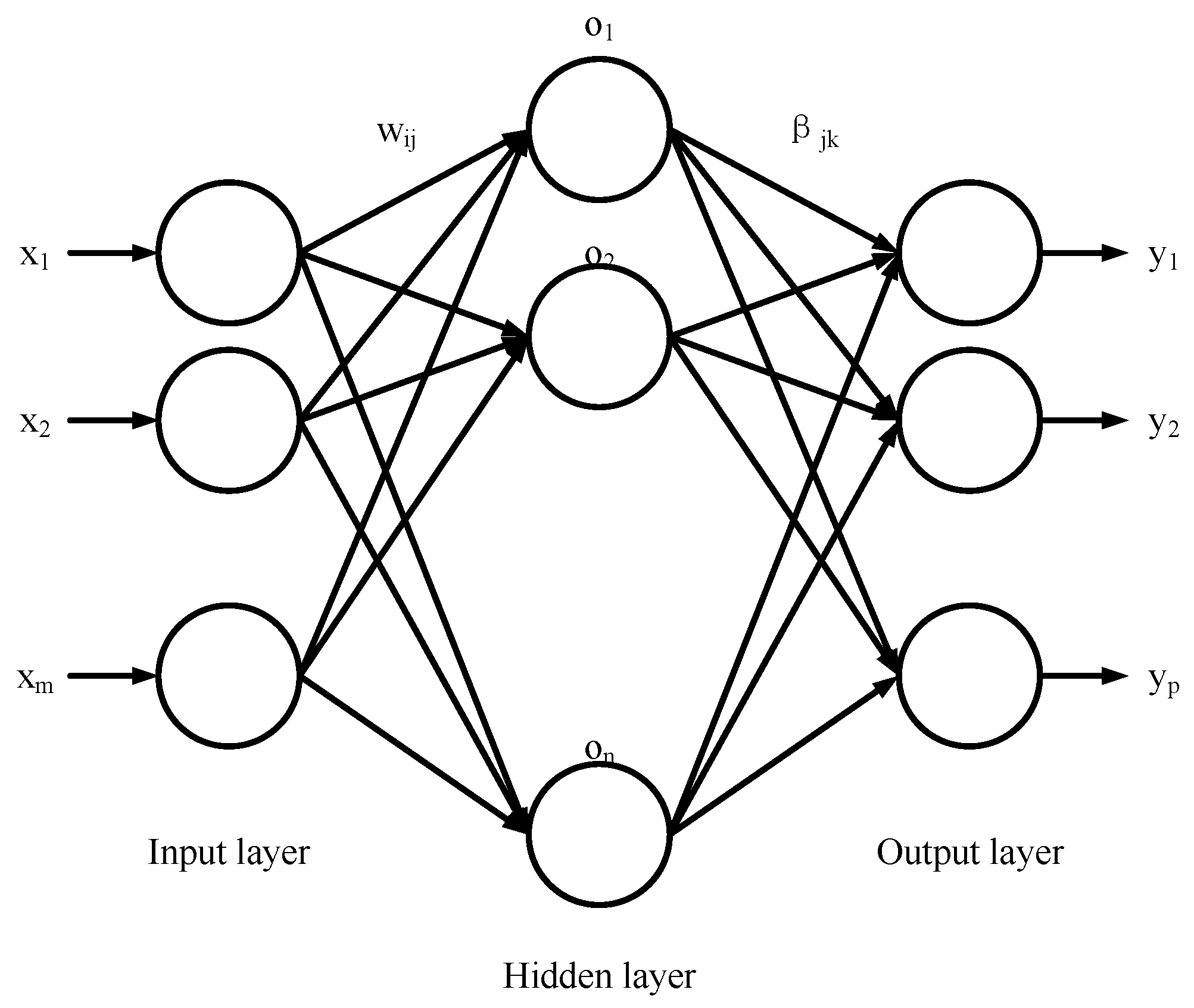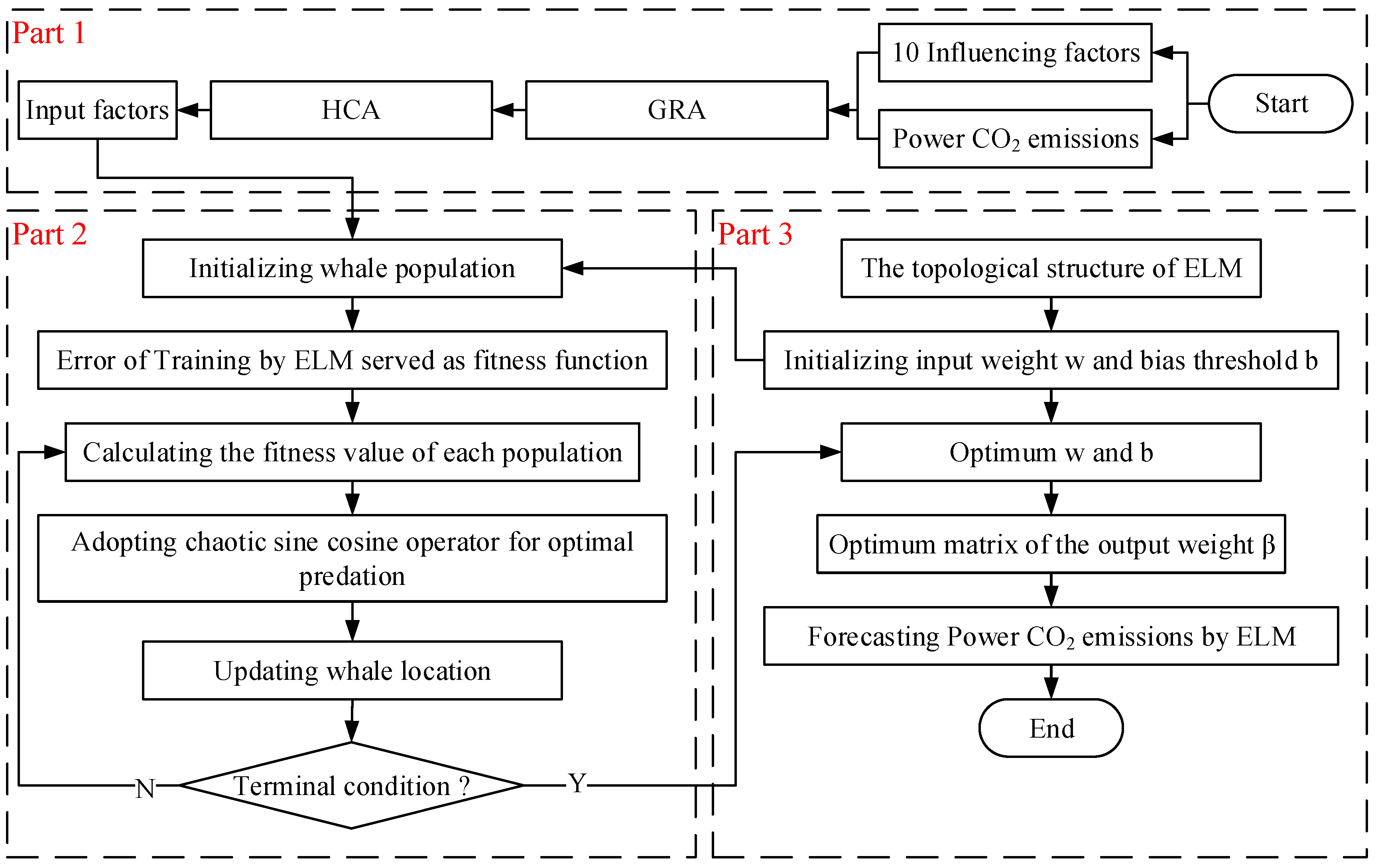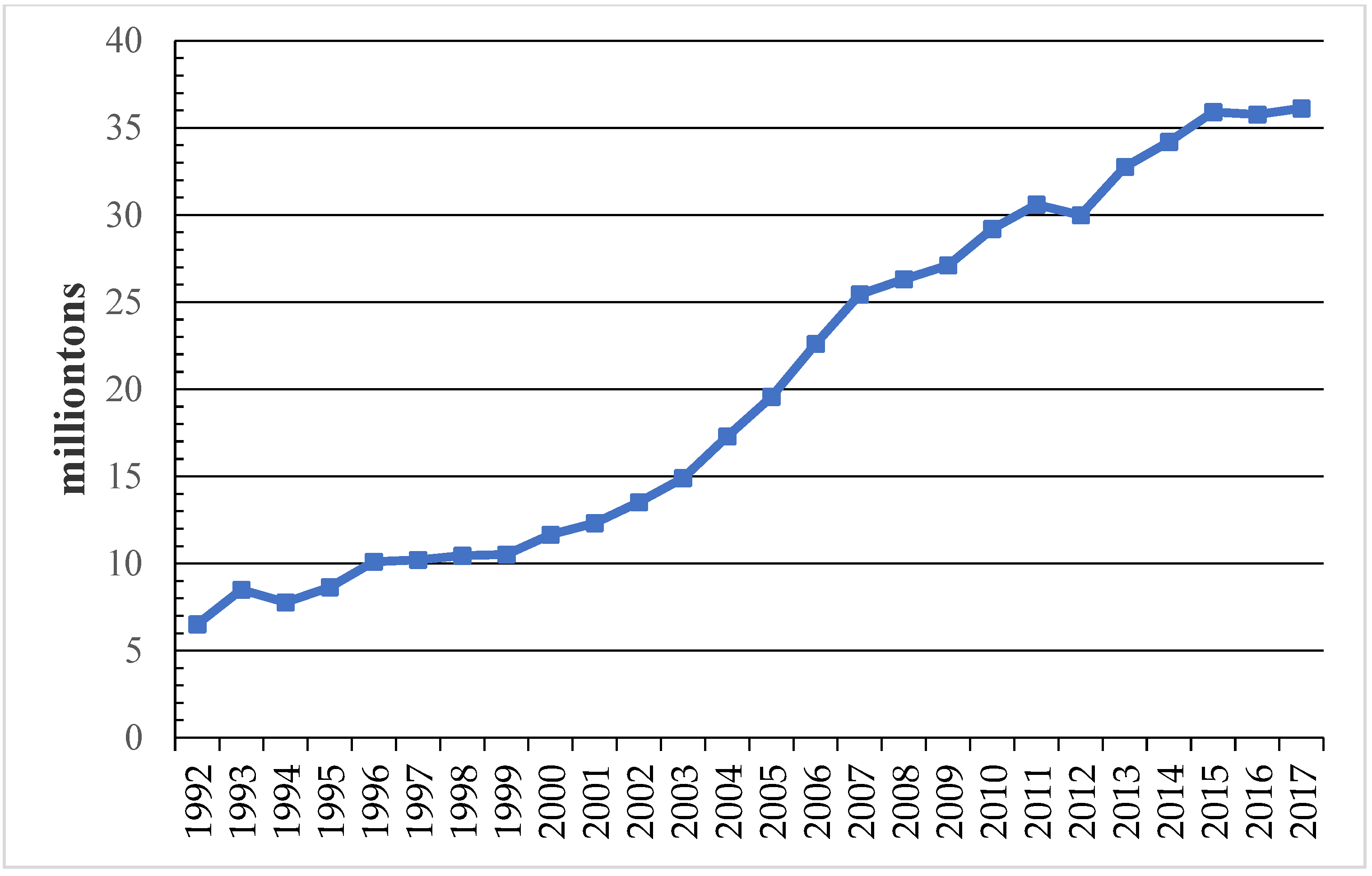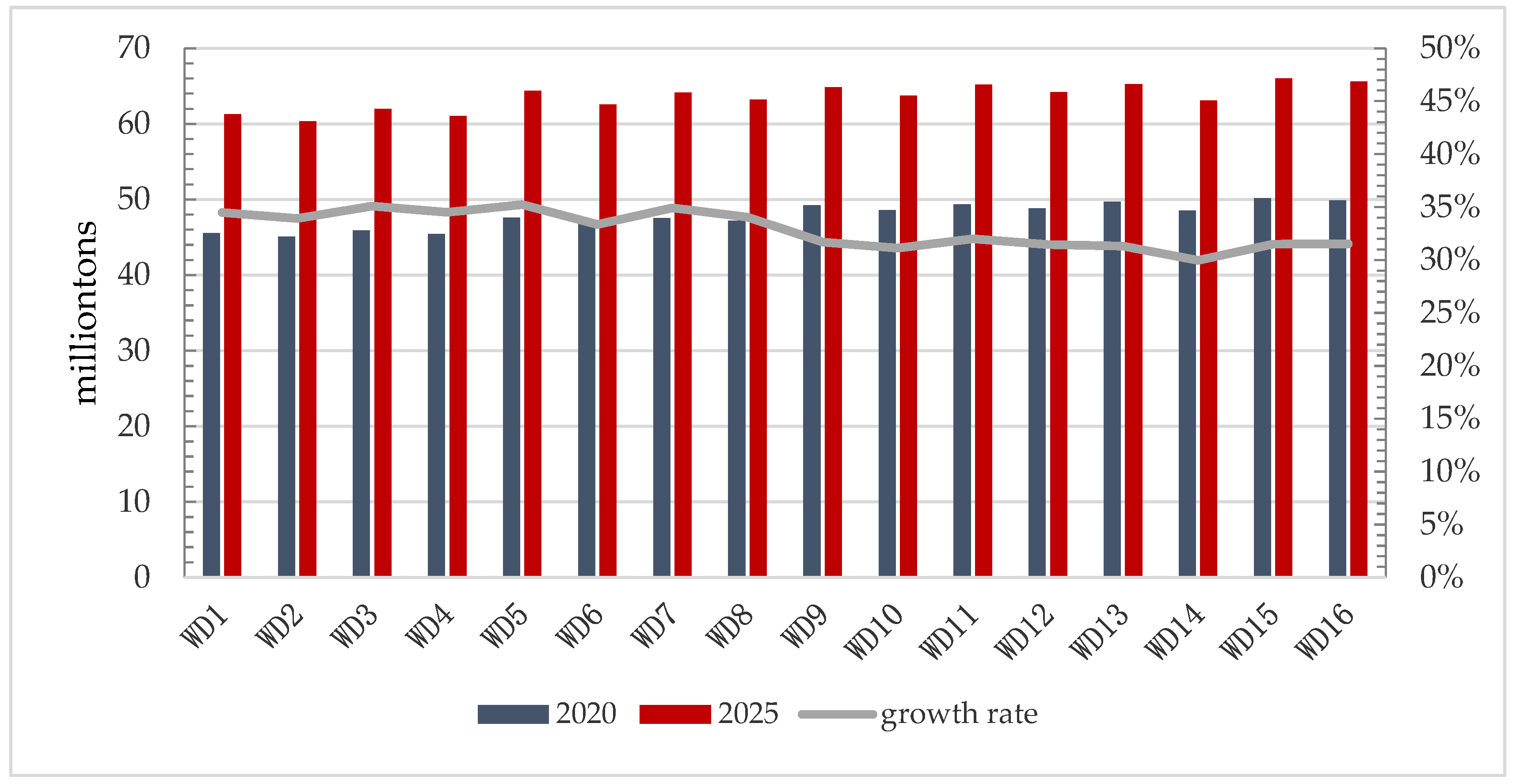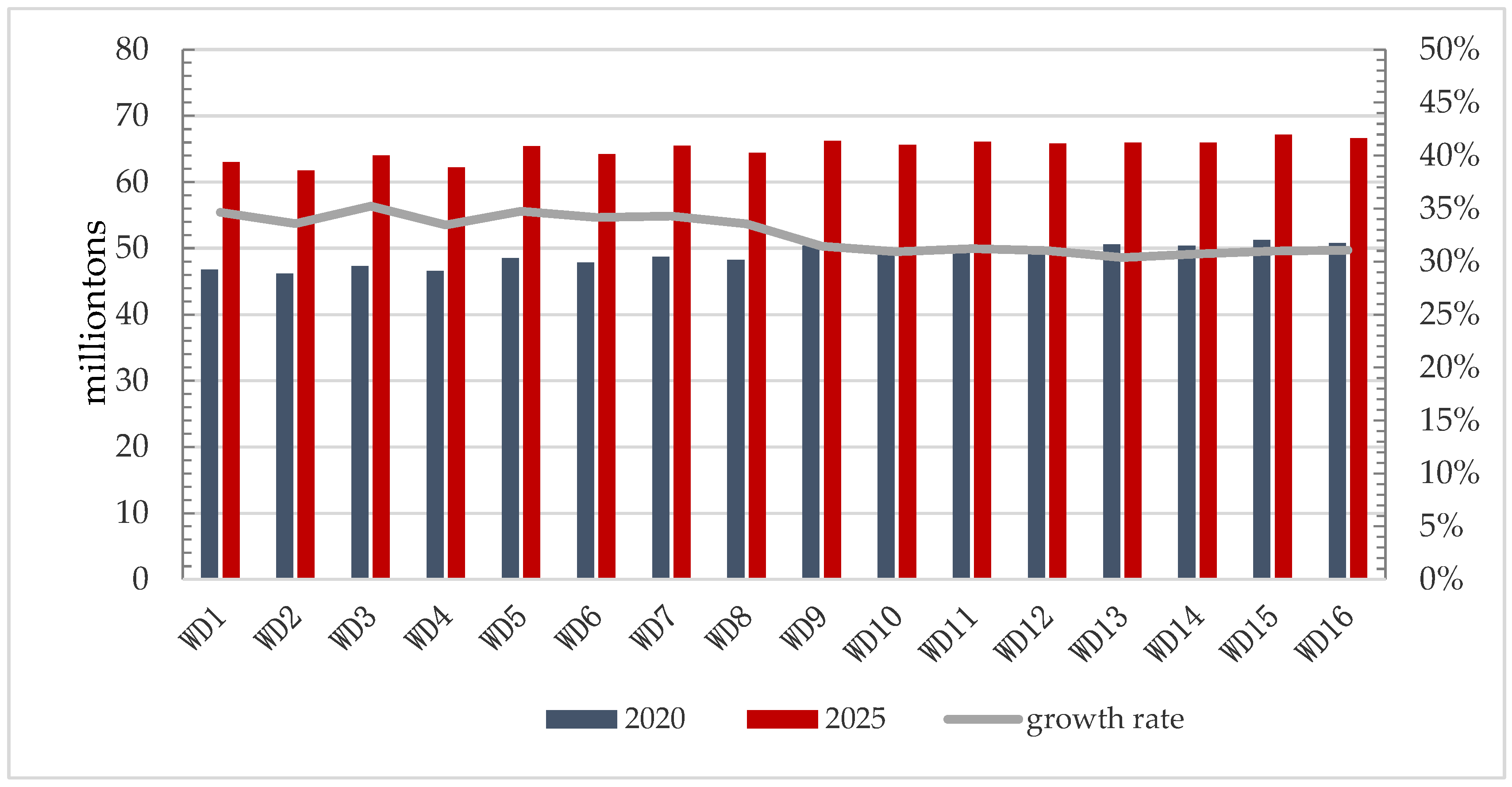1. Introduction
With the gradual increase of CO
2 emissions, global warming tends to be intensified, resulting in severe damage to the ecological environment [
1]. Since 2007, total CO
2 emissions in China have surpassed that of the United States, ranking first in the world [
2]. In 2016, the Global Carbon Atlas showed that the sum of global CO
2 emissions was about 34.81 billion tons and 29.16% was from China, which is more than the aggregate of the United States and the European Union [
3,
4,
5]. Under heavy international pressure for CO
2 reduction, active measures have been taken to save energy in China, aiming to cut down CO
2 emissions [
6]. In 2009, Chinese government promised at the Copenhagen climate negotiation conference that the CO
2 emission intensity in 2020 will be reduced by 40–45% compared with 2005 [
7]. Furthermore, a target was established by Chinese government at the UN General Assembly in 2015 that CO
2 emissions will reach a peak around 2030 and strive to peak as soon as possible, with the unit GDP of CO
2 emissions falling by 60–65% compared with 2005 [
8,
9]. Simultaneously, China’s 13th Five-Year development plan has put forward the higher goal of having the proportion of non-fossil energy consumption account for about 15% of primary energy until 2020 for power development [
10].
As regards electrical energy, it plays a significant role in China’s economic development and ranks first all over the world. Accounting for about 22.6% of terminal energy, electrical energy generates more than 40% of total CO
2 emissions [
11]. Obviously, reducing electricity carbon emissions is a problem to reduce total carbon emissions. Therefore, it is significant to explore the influencing factors of power CO
2 emissions and establish an accurate prediction model, aiming at reducing CO
2 emissions and promoting the development of low carbon economy.
Throughout the study of predecessors, there are many studies with research on the influencing factors of power CO
2 emissions with the method of logarithmic mean Diicks index (LMDI). Klein [
12] utilized Kaya Identity to obtain four factors, including population, GDP per capita, electricity intensity and the carbon intensity of electricity generation. According to the bottom-up sectoral and industry comprehensive assessment model (SIAM), Chai et al. [
13] evaluated the carbon emission management performance of China’s power industry and researched on the objectives and policies of total carbon emission control. With the goal of peak carbon emissions in 2030 and carbon tax as the driving factor for emission reduction, Ma et al. [
14] designed three emission reduction scenarios to forecast energy demand and carbon emissions under each scenario. Based on LMDI, Huo et al. [
15] established a decomposition model and calculated CO
2 emissions from power output, with the influencing factors decomposed into income effect, power production intensity effects, power production structure effects, population effects, and coal consumption effects of power generation. By establishing a factorization model based on the LMDI method, Hou et al. [
16] analyzed the influencing factors about the carbon intensity of electricity, which showed that the impacts from high to low are power generation structure, coal consumption of generation, line loss rate and plant power consumption rate. In terms of power production, transmission and consumption, Wang and Xie [
17] adopted the LMDI method to decompose the impact factors of power CO
2 emissions into emission factors, energy structure, power structure, conversion efficiency, transmission and distribution loss, economic scale, population scale, industry structure, electricity intensity and consumption. Considering power generation and consumption in the Beijing-Tianjin-Hebei region, Zhang [
18] used the LMDI hierarchical decomposition model to decompose the influencing factors into positive drivers and negative drivers. Specifically, the former included economic size, population size, thermal power conversion efficiency, and industrial structure effects, and the latter included industrial power intensity effect, coal consumption effect of power generation, electricity generation proportion effect, household electricity consumption intensity, power structure effect and coal consumption effect of generating electricity. As mentioned above, most scholars have adopted LMDI to decompose the influencing factors intuitively. However, some influencing factors have less contribution and correlation to power CO
2 emissions, resulting in inaccuracy of predictions.
Compared with the research on influencing factors, there are few studies predicting power CO
2 emissions. Wang and Luo [
19] used scenario analysis method to predict the power CO
2 emissions in Sichuan Province, setting up baseline scenario, technological progress scenario and energy structure optimization scenario. The results indicated that CO
2 emissions could be reduced in the last two scenarios. Based on the per capita electricity forecast method, the single output method and the per capita household electricity consumption method, Xu [
20] forecasted the medium- and long-term power load and CO
2 emissions of Baoding through the corresponding calculation formula. Liu et al. [
21] combined the autoregressive integrated moving average model and the second-order polynomial regression model to established a new forecasting mode, which was further optimized by particle swarm optimization (PSO). The results showed that the thermal power generation will reach 7258.83 billion kWh in 2020, with CO
2 emissions reaching up to 17,379.90 million tons. Through IPCC and GM (1, 1), Zhang et al. [
22] estimated and predicted the carbon emission intensity of various industries in Anhui province, indicating that the carbon reduction of power sector would rank third among all industries. In order to forecast the power CO
2 emissions, Wang et al. [
23] used VENSIM software to build a system dynamics model based on baseline scenario, low carbon scenario and ultra-low carbon scenario, and the results revealed that low carbon technology, power supply structure and industrial structure had great impact on low-carbon development of power industry. Wang et al. [
24] used the extended STIRPAT model to evaluate the reduction potential of CO
2 emissions in the industrial sub-sectors, which showed that the power industry is one of the industries with the most potential for emission reduction. In summary, the research scope about forecasting power CO
2 emissions is limited to provinces and municipalities. With fewer scenarios set up, existing studies were overly optimistic about China’s economic growth in the future. Furthermore, the prediction models mainly adopted mathematical method, which remains over-fitting and poor generalization capability. Therefore, it is necessary to reset and refine the development scenarios and established an accurate model for predicting power CO
2 emissions.
Given the above, this article selects the influence factors of power CO2 emissions in China by grey correlation analysis, and the HCA method is adopted to screen key factors with less redundancy as independent variables. In addition, the CSCWOA-ELM model is firstly adopted to predict the CO2 emissions from power output.
The remainder of this study is organized as follows. Firstly, the GRA is applied to select 11 influencing factors to form a perfect index system, highly correlated with power CO2 emissions. Secondly, 5 key factors are exacted from 11 influencing factors as input values of the prediction model by HCA, aiming to reduce redundancy and keep information integrity. Thirdly, CSCWOA-ELM model is established to predict the powerCO2 emissions, using 21 samples from 1992 to 2012 for training and 5 samples from 2013 to 2017 for testing. Finally, we put forward effective policy recommendations based on the above research.
4. Results and Discussions
In different essential development scenarios, the 5 key factors in16 specific scenarios are input into the CSCWOA-ELM model respectively. Ultimately, the predictions of powerCO2 emissions can be obtained in different scenarios.
4.1. Predictions in the Weakened Development Scenario
The weakened development scenario includes 16 specific scenarios, with the low-speed growth rates of living consumption level. Meanwhile, the other four influencing factors select different growth rates. The results are shown in
Figure 5.
As illustrated in
Figure 5, the predictions of power CO
2 emissions will increase by 29.96–35.23% from 2020 to 2025 in the weakened development scenario. In detail, the growth rates will remain at 33.35–35.23% in the scenarios WD1–WD8, and at 29.96–31.99% in the scenarios WD9–WD16. In general, the power CO
2 emissions in the scenarios WD9–WD16 are more than those in the scenarios WD1–WD8. Particularly, the power CO
2 emissions in the scenario WD15 will reach a maximum, with the growth rates of GDP and power structure at high level, the population growth rate at medium level, and the growth rates of the living consumption level and the thermal power conversion efficiency at low level. Meanwhile, the power CO
2 emissions in the scenario WD2 will reach a minimum, with the growth rates of GDP, the growth rates of power structure and the growth rates of thermal power conversion efficiency at medium level, the growth rates of population and the living consumption level at low level.
Furthermore, the results indicate that the growth rates of thermal power conversion efficiency is negative correlation with the power the CO2 emissions, while the others are positive. By comparing BD1 to BD9 (BD2 to BD10, BD3 to BD11, BD4 to BD12, BD5 to BD13, BD6 to BD14, BD7 to BD15, BD8 to BD16), the contribution rate of the GDP growth rate to the power CO2 emissions is 1.24%. Similarly, the contribution rates of the power structure growth rate, the thermal power conversion efficiency growth rate, and the population growth rate are0.63%, 0.47%, and 0.35% respectively. Based on the above, the contribution rates of the4 influencing factors from high to low are the growth rates of GDP, the growth rates of power structure, the growth rates of thermal power conversion efficiency, and the growth rates of population. As the growth rate of GDP increase by 1%, the power CO2 emissions will rise 1.24%. Similarly, the growth rate of power structure, the growth rate of thermal power conversion efficiency, and the growth rate of population increase by 1%, with the power CO2 emissions rising0.63%, 0.47%, and 0.35% in turn.
4.2. Predictions in the Based Development Scenarios
The based development scenario includes 16 specific scenarios, with the medium growth rates of living consumption level. As the other four influencing factors select different growth rates, the predictions of power CO
2 emissions are shown in
Figure 6.
According to
Figure 6, compared with 2020, the predictions of power CO
2 emissions in 2025 will increase by 30.38–35.22% in the based development scenario. In detail, the growth rates will remain at 33.46–35.22% in the scenarios WD1–WD8, and at 30.38–31.44% in the scenarios WD9–WD16. Furthermore, the power CO
2 emissions in the scenarios WD9-WD16 are higher than those in the scenarios WD1–WD8. Obviously, the power CO
2 emissions in the scenario WD15 will reach a maximum, with the growth rates of GDP and power structure at high level, the growth rates of living consumption level and population at medium level, and the growth rates of thermal power conversion efficiency at low level. In addition, the power CO
2 emissions in the scenario WD2 will reach a minimum, with the growth rates of population at low level, and the others at medium level.
By comparing BD1 to BD9 (BD2 to BD10, BD3 to BD11, BD4 to BD12, BD5 to BD13, BD6 to BD14, BD7 to BD15, BD8 to BD16), the contribution rate of the GDP growth rate to the power CO2 emissions is 1.33%. Similarly, the contribution rates of the power structure growth rate, the thermal power conversion efficiency growth rate, and the population growth rate are 0.61%, 0.46%, and 0.37% respectively. Therefore, the contribution rates of the 4 influencing factors are ordered in turn: the growth rate of GDP, the growth rate of power structure, the growth rate of thermal power conversion efficiency, and the growth rate of population. As the growth rate of GDP increases by 1%, the power CO2 emissions will rise 1.33%. Similarly, the growth rates of power structure, thermal power conversion efficiency, and population increase by 1%, leading to the power CO2 emissions rising 0.61%, 0.46%, and 0.37% respectively.
4.3. Predictions in the Strengthened Development Scenarios
The strengthened development scenario includes 16 specific scenarios, with the living consumption levels all maintaining high growth rates. Meanwhile, the other 4 influencing factors select different growth rates. The predictions of power CO
2 emissions in 2020 and 2025 are shown in
Figure 7.
As shown in
Figure 7, the predictions of the power CO
2 emissions will increase by 29.68–35.16% from 2020 to 2025 in the strengthened development scenario. Specifically, the growth rates will remain at 33.44–35.16% in the scenarios WD1–WD8, and at 29.68–32.06% in the scenarios WD9–WD16. Generally, the power CO
2 emissions in the scenarios WD9–WD16 are higher than those in the scenarios WD1–WD8. In particular, the power CO
2 emissions in the scenario WD15 will reach a maximum, with the growth rates of GDP, living consumption level, and power structure at high level, the growth rates of population at medium level, and the growth rates of thermal power conversion efficiency at low level. Simultaneously, the power CO
2 emissions in the scenario WD2 will reach a minimum, with the growth rates of living consumption level at high level, the population growth rate at low level, and the others at medium level.
By comparing BD1 to BD9 (BD2 to BD10, BD3 to BD11, BD4 to BD12, BD5 to BD13, BD6 to BD14, BD7 to BD15, BD8 to BD16), the contribution rate of the GDP growth rate to the power CO2 emissions is 1.28%. Similarly, the contribution rates of the power structure growth rate, the thermal power conversion efficiency growth rate, and the population growth rate are 0.61%, 0.5%, and 0.38% respectively. Based on the above, the contribution rates of the 4 influencing factors ordered from high to low are the growth rate of GDP, the growth rate of power structure, the growth rate of thermal power conversion efficiency, and the growth rate of population. As the growth rate of GDP increases by 1%, the power CO2 emissions will rise 1.28%. Similarly, the growth rates of power structure, thermal power conversion efficiency, and population increase by 1%, resulting in the power CO2 emissions rising 0.61%, 0.5%, and 0.38% respectively. In addition, through the comparison of WD1, BD1, and SD1 (WD2, BD2, and SD2; WD3, BD3, and SD3; ...; WD16, BD16, and SD16), the contribution rate of the living consumption level growth rate is 0.76%. That is, when the growth rate of living consumption level increases by 1%, the power CO2 emissions will rise 0.76%.
4.4. Comparisons of the Three Essential Development Scenarios
As shown in the comparison results, the power CO
2 emissions in the corresponding specific scenarios from the three essential scenarios, such as WD1, BD1 and SD1 (WD2, BD2 and SD2, WD3, BD3, and SD3; ...; WD16, BD16, and SD16), increase in turn. Furthermore, the growth rates of the power CO
2 emissions show a significant decline in general, fluctuating between 29.68–35.23%. Meanwhile, it is found that GDP, power structure, and the living consumption level are the main influencing factors of the power CO
2 emissions, with the contribution rates all above 0.6%. Nevertheless, the impacts of the thermal power conversion efficiency and population are small, with the contribution rates less than 0.5%. As consequence, the contribution rates of each influencing factor in the three essential scenarios are shown in
Table 8.
5. Conclusions
In this study, based on the correlation of influencing factors, 5 key factors are selected from 11 influencing factors through HCA. Furthermore, the prediction model of CSCWOA-ELM is established to forecast the power CO2 emissions in 48 specific development scenarios, with the contribution rates of 5 influencing factors calculated. Through the comparison within the three essential development scenarios, it is regarded as evident to conclude that: (1) With an average contribution rate of 1.28%, GDP is the biggest influencing factor of the power CO2 emissions. (2) With an average contribution rate of 0.62%, the power structure is also a significant influencing factor. Through the comparison among the three essential development scenarios, we can draw the conclusion that: (3) the average contribution rate of the living consumption level is 0.76%, which is higher than that of the power structure. To sum up, GDP, the power structure, and the living consumption level are the most important influential factors of the power CO2 emissions in China.
As we know, the power output in China generates a large number of CO2, posing a serious threat to the reduction of CO2 emissions. Based on the above, some recommendations for the reduction of the power CO2 emissions in China are proposed as follows: (1) As industry plays a significant role in China’s economy, the industrial power consumption accounts for around 71.6% of the total, and the unit power consumption is 23.45 kWh/million, which was 15.95 times than that of the service. Therefore, it is recommended that High-tech industries and service industry should be promoted to achieve the economic growth without considerable CO2 emissions. (2) The thermal power production, accounting for around 73.7% of power output, is main source of CO2 emissions, resulting in serious air pollution. Hence, improving the proportion of clean power generation is an effective measure to reduce power CO2 emissions, based on the implementation of clean energy policies. Furthermore, new technologies and equipment should be applied to increase the conversion efficiency of thermal power, which is conducive to reducing the consumption of coal and petroleum. (3) With regard to the power waste, more attention should be taken to the awareness of energy conservation. With the living standards improving gradually, the degree of household electrification continues to increase, driving the power consumption and CO2 emissions. In order to solve the above problem, the government should also strengthen propaganda to cultivate the conservation awareness, and the focus of emission reduction should be concentrated on the optimization of the power structure. Finally, these recommendations can be regarded as a reference for China’s 14th Five-Year development to cut down CO2 emissions.
